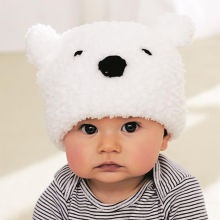Good question. What are buff mittens? I’ve never heard of them before, but today, Knitting Daily e-newsletter featured an article from PieceWork magazine that was published in Fall 2011. The following is quoted from that article, “Annis Holmes’s Buff Knitting: Preserving and Updating a North Country Tradition.” The North Country cited includes New England, which increased my interest, being a lifelong native of the region.
According to author Joanna Johnson, “In winter during the late nineteenth and early twentieth centuries, warm, windproof, and waterproof mittens, deemed ‘buff mittens,’ were a mainstay for loggers and others laboring in the woods of the Adirondack region of New York, New England, and neighboring Canada….The term ‘buff’ may refer to the felted pile or to the undyed yarn that typically was used to make the mittens.”
Curious about the term “buff”, I checked it out in several dictionaries, but none of the definitions I found relate to mittens or even to knitting. Instead, a soft, thick leather with a napped surface, often made from buffalo skin, was known as buff. Then there were the more common meanings, such as a brownish yellow color, a polishing process, bare skin, a devotee of some particular subject or activity, or the slang for physically fit. Interestingly, American colonists in the 17th century wore a short, thick coat made of buffalo leather, called a buffcoat.

But back to the mittens. For PieceWork’s 10th annual Historical Knitting Issue, available now, Joanna designed the child’s buff mittens seen in the photo. If you want to know how that soft fuzzy surface is made, you can order a kit, or read about it in the magazine. Basically, it involves knitting the fabric with loops on the surface, then cutting, trimming, and fulling the finished product. Sounds like the embroidery technique of Turkey work, aka Ghiordes Knot, for which there are numerous tutorials online.
More info about this project, including where to get the mitten kit, is available right over here .
(Wonder how these mittens hold up after multiple washings and wearings. They recall to mind some dusting mitts my mother used to have.)
 The most adorable hat pattern I’ve seen all year! Requires only one skein of Bernat’s Pipsqueak yarn, which is light and soft as a cloud. And it knits up fast on size 10 (US) needles. I’ve made several of these charmers and they’re always a hit. What a cool gift for any little person living where it gets cold in winter.
The most adorable hat pattern I’ve seen all year! Requires only one skein of Bernat’s Pipsqueak yarn, which is light and soft as a cloud. And it knits up fast on size 10 (US) needles. I’ve made several of these charmers and they’re always a hit. What a cool gift for any little person living where it gets cold in winter.
 Just posted today by Classic Elite on their website. This little beauty comes in sizes 18 months to 6 years. The one pictured is made with Princess yarn, and because it’s made in one piece (my favorite kind), it requires 2 circular needles, size 5 and 6 (US).
Just posted today by Classic Elite on their website. This little beauty comes in sizes 18 months to 6 years. The one pictured is made with Princess yarn, and because it’s made in one piece (my favorite kind), it requires 2 circular needles, size 5 and 6 (US).



 found primarily in temperate regions of the northern hemisphere, often ranging farther north and higher in altitude than other bees. Fifty species of bumble bees are known in North America alone! Bumble bees are similar to their close relatives, the honey bees, in that their colonies are headed by a queen, who is the main egg-layer, and many workers, who are the daughters of the queen, and in that drones (males) are produced during the mating
found primarily in temperate regions of the northern hemisphere, often ranging farther north and higher in altitude than other bees. Fifty species of bumble bees are known in North America alone! Bumble bees are similar to their close relatives, the honey bees, in that their colonies are headed by a queen, who is the main egg-layer, and many workers, who are the daughters of the queen, and in that drones (males) are produced during the mating This new pattern just out from
This new pattern just out from  I love knitting sweaters all in one piece, and Petite Purls has just posted a lovely little girls’ cardigan that fits the bill. It’s also worked from side to side. Using short rows, Kitchener stitch, and provisional cast on, this project requires size 9 (US) needles and worsted weight yarns. It’s perfect for my little granddaughters, who are both as sweet as the little girl in this photo.
I love knitting sweaters all in one piece, and Petite Purls has just posted a lovely little girls’ cardigan that fits the bill. It’s also worked from side to side. Using short rows, Kitchener stitch, and provisional cast on, this project requires size 9 (US) needles and worsted weight yarns. It’s perfect for my little granddaughters, who are both as sweet as the little girl in this photo. pattern
pattern